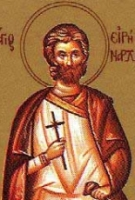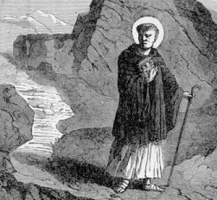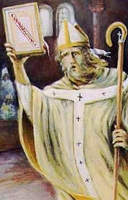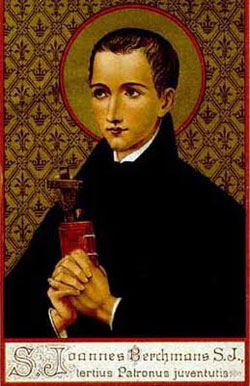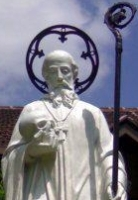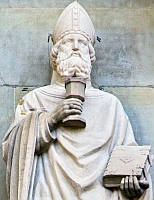Saint James of the Marches
மார்ச்சிஸ் நகர புனிதர் ஜேம்ஸ்
ஃபிரான்சிஸ்கன் துறவி/ பிரசங்கிப்பாளர்/ எழுத்தாளர்:
(Friar Minor, Preacher and Writer)
பிறப்பு: கி.பி. 1391
மோண்டேப்ராண்டோன், அன்கொனாவின் மார்ச், திருத்தந்தையர் மாநிலம்
(Monteprandone, March of Ancona, Papal States)
இறப்பு: நவம்பர் 28, 1476
நேப்பிள்ஸ், நேப்பிள்ஸ் அரசு
(Naples, Kingdom of Naples)
ஏற்கும் சமயம்:
ரோமன் கத்தோலிக்க திருச்சபை
(Roman Catholicism)
(ஃபிரான்சிஸ்கன் சபை - Franciscan Order)
அருளாளர் பட்டம்: கி.பி. 1624
திருத்தந்தை எட்டாம் அர்பன்
(Pope Urban VIII)
புனிதர் பட்டம்: டிசம்பர் 10, 1726
திருத்தந்தை பதின்மூன்றாம் பெனடிக்ட்
(Pope Benedict XIII)
முக்கிய திருத்தலம்:
மார்ச்சிஸ் நகர் புனிதர் ஜேம்ஸின் தேவ இல்லம், மோண்டேப்ராண்டோன், அஸ்காலி பிக்கெனோ, இத்தாலி
(Sanctuary of St. James of the Marches, Monteprandone, Ascoli Piceno, Italy)
நினைவுத் திருநாள்: நவம்பர் 28
பாதுகாவல்:
மோண்டேப்ராண்டோன் (Monteprandone);
நேப்பிள்ஸ், இத்தாலியின் இணை பாதுகாவலர் (Co-Patron of Naples, Italy)
புனிதர் ஜேம்ஸ், ஒரு இத்தாலிய இளம் துறவியும், மறை போதகரும், எழுத்தாளரும், ஆவார். “டொமினிக் கங்காலா” (Dominic Gangala) எனும் இயற்பெயர் கொண்ட இவர், மத்திய இத்தாலியின் அந்நாளைய “அன்கொனாவின் மார்ச்” (March of Ancona) எனும் இடத்திலுள்ள “மோண்டேப்ராண்டோனில்” (Monteprandone) ஒரு ஏழைக் குடும்பத்தில் பிறந்தார்.
இளம் வயதில் தமது மாமன் உறவிலுள்ள ஒரு மத குருவின் மேற்பார்வையில் கல்வி கற்ற இவர், பெருஜியா பல்கலைகழகத்தில் (University of Perugia) கேனான் மற்றும் சிவில் சட்டம் ஆகிய கல்வியில் முனைவர் பட்டம் பெற்றார்.
கி.பி. 1416ம் ஆண்டு, ஜூலை மாதம், 26ம் நாள், அசிஸியிலுள்ள (Assisi) “போர்ட்டின்குளா” சிற்றாலயத்தின் (Chapel of the Portiuncula) இளம் துறவிகள் மடத்தில் இணைந்தார். அப்போது அவர் தமது பெயரை ஜேம்ஸ் என்று மாற்றிக்கொண்டார்.
புனிதர் சியென்னா நகர் பெர்னார்டின் (St. Bernardine of Siena) அவர்களின் மேற்பார்வையில் இறையியல் பயின்றார்.
13 ஜூன் 1420 அன்று குருத்துவ அருட்பொழிவு பெற்ற இவர், விரைவிலேயே “டுஸ்கனி” (Tuscany), “மார்ச்செஸ்” (Marches), “உம்பிரியா” (Umbria) ஆகிய இடங்களில் மறை போதனை செய்ய தொடங்கினார்.
கி.பி. 1427ம் ஆண்டு முதல் சுமார் அரை நூற்றாண்டுகள் இவர் சீரிய முறையில் மறை போதனை செய்தார். தவ வாழ்வு பற்றி போதித்தார். கிறிஸ்துவுக்கு எதிரானவர்களுக்கெதிராக போரிட்டார். ஜெர்மனி (Germany), ஆஸ்திரியா (Austria), ஸ்வீடன் (Sweden), டென்மார்க் (Denmark), போஹெமியா (Bohemia), போலந்து (Poland), ஹங்கேரி (Hungary) மற்றும் போஸ்னியா (Bosnia) ஆகிய நாடுகளில் சிறப்பாக மறை பணியாற்றினார்.
“ஃபிரான்சிஸ்கன் சபையின் விழிப்போடு கவனிக்கின்ற” (Observant Branch of the Friars Minor) கிளையைச் சேர்ந்த இவர், சிறப்புமிக்க மறை போதகர் ஆவார்.
தனது வாழ்க்கையின் கடைசி மூன்று ஆண்டுகளை “நேபிள்ஸில்” (Naples) கழித்த ஜேம்ஸ், கி.பி. 1476ம் ஆண்டு, நவம்பர் மாதம், 28ம் நாளன்று மரித்தார்.
Also known as
• Dominic Gangala
• Giacomo della Marca
• Jacopo Gangala
• James della Marca
• James Gangala
• James of La Marca of Ancona
• James of Picenum
Profile
Born poor. Doctor of Civil Law. Franciscan monk at age 22. Studied with Saint John of Capistrano. Disciple of Saint Bernadine of Siena. Tutor. Judge of sorcerers. Ordained in 1423. Preacher and evangelist throughout Central and Northern Europe, preaching every day for 40 years. Brought Blessed Bernardino of Feltre and Blessed Bernardino of Fosso into the Franciscans. Travelled and worked with Saint John Capistrano. Inquisitor in 1426, assigned to crush the heretical Fraticelli. Worked against the Bogomil heresy in Bosnia in 1432. Founded several monasteries in Bohemia, Hungary, and Austria. Chief almoner for the 1437 Crusade against the Turks. Worked at the Council of Florence in 1438 to re-unite the Eastern and Latin Churches. Papal legate in 1456. Preached against the Hussites in Austria and Hungary. The Dominican Inquisitors made him the subject of an inquiry in 1462 when they thought that one of his statements on the Precious Blood was heretical; Rome ordered the case to be put permanently on hold, and it was never settled. A skinny man who dressed in a tattered habit, he fasted every day until his health began to fail - and the pope ordered him to eat as a public service.
Born
1 September 1391 at Monteprandone, March of Ancona, Italy as Dominic Gangala
Died
• 28 November 1476 at Naples, Italy
• buried at the church of Santa Maria Nuova, Naples
Canonized
10 December 1726 by Pope Benedict XIII
Patronage
• Monteprandone, Italy
• Naples, Italy
Representation
• priest holding in his right hand a chalice from which a snake is escaping
• chalice and serpent
• Franciscan holding a chalice and a veil
• Franciscan with a staff, castanets at his girdle, pointing to IHS
Saint Catherine Laboure
புனிதர் கேதரின் லபோர்
கருணையின் அருட்சகோதரி/ மரியன்னை திருக்காட்சியாளர்:
(Sister of Charity, Marian visionary)
பிறப்பு: மே 2, 1806
ஃபெய்ன்-லெஸ்-மௌடியர்ஸ், கோடே-டி’ஓர், ஃபிரான்ஸ்
(Fain-lès-Moutiers, Côte-d'Or, France)
இறப்பு: டிசம்பர் 31, 1876 (வயது 70)
இங்கியன்-லெஸ்-பெய்ன்ஸ், செய்ன்-எட்-ஒயிஸ், ஃபிரான்ஸ்
(Enghien-les-Bains, Seine-et-Oise, France)
ஏற்கும் சமயம்:
ரோமன் கத்தோலிக்க திருச்சபை
(Roman Catholici Church)
அருளாளர் பட்டம்: மே 28, 1933
திருத்தந்தை 11ம் பயஸ்
(Pope Pius XI)
புனிதர் பட்டம்: ஜூலை 27, 1947
திருத்தந்தை 12ம் பயஸ்
(Pope Pius XII)
சித்தரிக்கப்படும் வகை: அற்புத பதக்கம் (Miraculous Medal)
நினைவுத் திருவிழா: நவம்பர் 28
பாதுகாவல்:
அற்புத பதக்கம் (Miraculous Medal), பலவீனமான மக்கள் (Infirmed people), முதியோர் (The elderly People)
"ஸோ லபோர்" எனும் (Zoé Labouré) எனும் இயற்பெயர் கொண்ட புனிதர் கேதரின் லபோர், "தூய வின்சென்ட் தெ பவுலின் பிறரன்பின் புதல்வியர்" (Daughters of Charity of Saint Vincent de Paul) துறவற சபையின் அருட்சகோதரியும், அன்னை மரியாளை தரிசித்த திருகாட்சியாளரும் ஆவார். மரியாளின் அறிவுறுத்தலின்படி, இவர் அற்புத பதக்கம் அணியும் வழக்கத்தை கிறிஸ்தவர்களிடையே உருவாக்கினார்.
தொடக்க காலம்:
கேதரின் லபோர், ஃபிரான்ஸ் நாட்டின் பர்கண்டி பகுதியில், "பியர் லபோர்" (Pierre Labouré) என்னும் விவசாயி தந்தைக்கும் "லூயிஸ் மடலின் கோண்டார்ட்" (Louise Madeleine Gontard) என்னும் தாய்க்கும் பிறந்த பதினோரு குழந்தைகளில் ஒன்பதாவது மகளாக 1806ம் ஆண்டு, மே மாதம், 2ம் தேதி பிறந்தார். கி.பி. 1815ம் ஆண்டு, அக்டோபர் மாதம், 9ம் தேதி, தமது 9 வயதில் தாயை இழந்தார். அப்போது இவர் மரியன்னையின் ஒரு சொரூபத்தை முத்தம் செய்து, "இப்போது முதல் நீரே என் தாய்" என்று கூறினார்.
அதன் பிறகு, இவர் உறவினர் ஒருவர் வீட்டில் வளர்க்கப்பட்டார். சிறு வயது முதலே, இவர் மரியன்னை மீது அன்பும் பக்தியும் கொண்டிருந்தார். இளம்பெண்ணாக இருந்தபோது, பிறரன்பின் புதல்வியர் துறவற சபையில் உறுப்பினராக இணைந்தார். அதன் மற்ற உறுப்பினர்களோடு இணைந்து பிறரன்பு பணிகளை செய்து வந்தார்.
திருக்காட்சியாளர்:
கி.பி. 1830ம் ஆண்டு, ஜூலை மாதம், 8ம் தேதி, இரவில் கேதரின் உறங்கிக்கொண்டிருந்த வேளையில் ஒரு குழந்தை இவரைச் சிற்றாலயத்திற்கு அழைத்த குரல் கேட்டு விழித்து எழுந்தார். உடனே இவர் சிற்றாலயத்திற்கு விரைந்து சென்றார். அங்கு மரியன்னை நிற்கும் காட்சியை தரிசித்தார். அன்னை மரியாள் இவரிடம், "கடவுள் உன்னை முக்கியமான ஒரு பணிக்குத் தேர்வு செய்துள்ளார்" என்று கூறி மறைந்தார்.
கி.பி. 1830ம் ஆண்டு, நவம்பர் மாதம், 27ம் தேதி, அன்னை மரியாள் மீண்டும் இவருக்கு காட்சி அளித்தார். அப்போது மரியன்னை உலக உருண்டை மேல் நின்று கொண்டிருந்தார். அவரது கரங்களில் இருந்து ஒளிக் கதிர்கள் வெளிவந்தன. மரியன்னையைச் சுற்றி முட்டை வடிவில் தோன்றிய ஒளி வட்டத்தில், "ஓ பாவமின்றி உற்பவித்த மரியாளே, உம்மை அண்டி வரும் எங்களுக்காக வேண்டிக்கொள்ளும்" என்ற வார்த்தைகள் காணப்பட்டன. காட்சி பின்பக்கம் திரும்பியது. அதில் சிலுவை அடையாளமும், அதன் கீழ் மாதாவை குறிக்கும் 'எம்' (M) என்ற எழுத்தும் காணப்பட்டன. அதன் அடியில் இயேசுவின் திவ்விய இருதயமும், மரியன்னையின் மாசற்ற இருதயமும் காணப்பட்டன. அவற்றைச் சுற்றி 12 விண்மீன்களும் காணப்பட்டன.
புதுமைப் பதக்கம்:
அந்த காட்சி முடிந்ததும் மரியன்னை கேதரினிடம், காட்சியில் கண்டது போன்ற ஒரு பதக்கத்தை கழுத்தில் அணியும் வகையில் தயார் செய்யச் சொன்னார். மேலும் இந்த அற்புத பதக்கத்தை அணிந்து கொள்பவர்கள் இயேசுவுக்கு ஏற்றவர்களாக வாழ்வார்கள் என்றும், பாவ வாழ்வில் இருந்து விலகுவார்கள் என்றும், மரியன்னை அறிவித்தார்.
இந்த காட்சிகளின் உண்மைத் தண்மை பின்பு திருச்சபையால் உறுதி செய்யப்பட்டது. கேதரினும் அன்னை மரியாள் சொன்னபடி செய்து, மக்கள் பலரும் அற்புத பதக்கத்தை அணிய வழிகாட்டினார். அதைக் கழுத்தில் அணிந்துகொண்ட பலரும் பல்வேறு நன்மைகளை அடைந்தனர். கிறிஸ்தவர்கள் அல்லாத சிலர் இந்த அற்புத பதக்கத்தை அணிந்து கொண்டதால் கிறிஸ்தவ விசுவாசத்தை ஏற்றுக்கொண்டதாக கூறப்படுகிறது.
முன்னறிவிப்புகள்:
கேதரின் லபோர், எதிர் காலத்தில் நடக்கவிருந்த சம்பவங்களை முன்னறிவிக்கும் வரமும் பெற்றிருந்தார். இவர் முன்னறிவித்தபடியே பல்வேறு முக்கிய நிகழ்வுகள் நடந்தேறின. ஆனால் சில முன்னறிவிப்புகள் பலிக்கவில்லை என்றும் கூறப்படுகிறது.
இறப்பு:
தனது வாழ்நாள் முழுவதையும் கடவுள் பக்தியின் மேன்மைக்காகவும், மரியன்னையின் பக்தியைப் பரப்பவும், அர்ப்பணித்த கேதரின், 1876ம் ஆண்டு, டிசம்பர் மாதம், 31ம் நாள் மரணம் அடைந்தார்.
புனிதர் பட்டம்:
கி.பி. 1933ம் ஆண்டு, மே மாதம், 28ம் தேதி, திருத்தந்தை 11ம் பயஸ் இவருக்கு அருளாளர் பட்டம் வழங்கினார்.
கேதரின் இறந்த 57 ஆண்டுகளுக்கு பிறகு, இவரது கல்லறைத் தோண்டப்பட்ட வேளையில் கேதரினின் உடல் அழியாத நிலையில் கண்டெடுக்கப்பட்டது.
கி.பி. 1947ம் ஆண்டு, ஜூலை மாதம், 27ம் தேதி, திருத்தந்தை 12ம் பயஸ் இவருக்கு புனிதர் பட்டம் வழங்கினார். புனிதர் கேதரின் லபோரின் அழியாத உடல், ஃபிரான்ஸ் நாட்டின் பாரிஸ் நகரில் “ரியூ டு பக்” (Rue du Bac) எனுமிடத்திலுள்ள “அற்புத பதக்க அன்னை சிற்றாலயத்தில்” (Chapel of Our Lady of the Miraculous Medal) இன்றளவும் பாதுகாக்கப்பட்டு வருகிறது.
Also known as
• Zoe Laboure
• Catherine Labore
Profile
Ninth of eleven children born to a farm family, and from an early age Catherine felt a call to the religious life. Never learned to read or write. Forced to take over running the house at age eight after her mother died and her older sister joined the Sisters of Charity. Worked as a waitress in her uncle's cafe in Paris, France. Upon entering a hospital run by the Sisters of Charity she received a vision in which Saint Vincent de Paul told her that God wanted her to work with the sick, and she later joined the Order, taking the name Catherine.
On 18 July 1830 she had a vision of Our Lady who described to her a medal which she wished struck. On one side it has the image of Our Lady, and the words, "O Mary, conceived without sin, pray for us who have recourse to thee"; on the other are the hearts of Jesus and Mary. Our Lady told Catherine that wearers of the medal would receive great graces, it has become known as the Miraculous Medal, and its wearing and devotion has spread worldwide. Miracles reported at her tomb.
Born
2 May 1806 at Fain-les-Moûtiers, Côte d'Or, Burgundy, France as Zoe Laboure
Died
• 31 December 1876 at Enghien-Reuilly, France
• body incorrupt
• entombed in her convent chapel
Canonized
27 July 1947 by Pope Pius XII
Patronage
• pigeon fanciers
• pigeons
Saint Stephen the Younger
Also known as
Stephen the New
Profile
Monk at the monastery of Saint Auxentius at age fifteen. Abbot of Saint Auxentius in 744. Retired in 756 to live as a hermit. Soon after, the iconoclast movement became very active in the area, led by Emperor Constantine Copronynus V. The emperor tried to enlist Stephen in the movement, but the holy hermit refused, and was exiled. Years later he returned, and to prove how important it was to respect icons and other religious art, Stephen went to the emperor, pulled out a coin that bore the emperor's likeness, threw it onto the floor, and stomped on it; as the emperor understood the importance of his own image, he imprisoned Stephen for 11 months. On his release, Stephen returned to the court and resumed the argument as though nothing has happened. He was ordered executed with more than 300 others who opposed iconoclasm.
Born
714 at Constantinople
Died
scourged, stoned and dragged to death through the streets of Constantinople in 764
Patronage
• coin collectors, numismatists
• smelters
Blessed Luis Campos Górriz
Profile
Educated from age 7 by Jesuits. From 1921 to 1926 he studied law and philosophy at the University of Valencia. While in university, he worked with Marian congregations. Began work as a lawyer in 1930. Married to Carmen Arteche Echeturia in the archdiocese of Valencia, Spain on 25 May 1933. General secretary of Catholic Action in Madrid, Spain in 1933. Father of one daughter. Widower in 1935. Martyred in the Spanish Civil War; he died with a rosary in his hand.
Born
30 June 1905 in Valencia, Spain
Died
28 November 1936 in Picadero de Paterna, Valencia, Spain
Beatified
11 March 2001 by Pope John Paul II
Saint Anrê Tran Van Trông
Also known as
Andrew Trong Van Tram
Additional Memorial
24 November as one of the Martyrs of Vietnam
Profile
Raised Catholic, but he kept quiet about it in public. Lifelong layman. Career soldier and officer. Worked to help the missionaries of the Paris Foreign Mission Society. In 1834 authorities discovered Andrew's Catholicism; he was stripped of rank and imprisoned for the faith. He was given the opportunity to gain his freedom by renouncing Christianity; he declined. Martyr.
Born
c.1808 in Kim Long, Thùa Thiên, Vietnam
Died
• beheaded on 28 November 1835 in An Hòa, Quang Nam, Vietnam
• his mother knelt beside the executioner's block to catch his severed head as it fell
Canonized
19 June 1988 by Pope John Paul II
Saint Sosthenes of Colophon
Also known as
Sosthenes of Corinth
Additional Memorials
• 9 December (Byzantine calendar)
• 30 March (Eastern calendar)
Profile
First century leader of the synagogue at Corinth. Convert, led to the faith by Saint Paul the Apostle, and mentioned in the opening of the 1st Epistle to the Corinthians. First bishop of Colophon, Asia Minor. Martyr.
Blessed James Thompson
Also known as
James Hudson
Additional Memorial
29 October as one of the Martyrs of Douai
Profile
Educated at Cardinal Allen's college at Rheims, France. Ordained at Soissons, France. Returned to York, England to minister to covert Catholics during a period of persecution, using the name James Hudson. Imprisoned and executed for the crime of being a priest in England.
Born
16th century York, North Yorkshire, England
Died
hanged on 28 November 1582 at York, North Yorkshire, England
Beatified
29 December 1886 by Pope Leo XIII (cultus confirmation)
Saint Simeon the Logothete
Also known as
Simeon Metaphrastes
Profile
Logothete (secretary of state) to Emperor Constantine VII Porphyrogenitus. Wrote history, prayers, letters, and collections of wisdom of Basil and Macarius of Egypt, but is most famous for his collection of legends and stories of the Byzantine saints similar to Blessed Jacopo de Voragine's The Golden Legend.
Died
c.1000 of natural causes
Saint Irenarcus
புனித_ஜரேனார்குஸ் (நான்காம் நூற்றாண்டு)
நவம்பர் 28
இவர் (#St_Irenarcus) உரோமை மன்னன் தியோகிளசியனின் படையில் படைவீரராகப் பணியாற்றி வந்தார்.
கிறிஸ்தவர்களைப் பலவாறாகக் கொடுமைப்படுத்திக் கொலை செய்யும் வேலையைச் செய்து வந்த இவர், கிறிஸ்தவர்கள், அதிலும் குறிப்பாக பெண்கள், துன்பங்களுக்கு நடுவிலும் இயேசுவின்மீது கொண்ட நம்பிக்கையில் மிக உறுதியாக இருந்ததைக் கண்டு வியந்து, கிறிஸ்துவை ஏற்றுக் கொண்டார்.
இதன் பிறகு இவர் கிறிஸ்தவர்களைத் துன்புறுத்து விட்டுவிட்டு, அவர்மீது ஆழமான நம்பிக்கை கொண்டு வாழத் தொடங்கினார்.
இதையறிந்த மன்னன் தியோகிளசியன் இவரைக் கொன்று போட்டான்.
இவ்வாறு இவர் ஆண்டவர் இயேசுவின்மீது கொண்ட நம்பிக்கைக்காகத் தன் இன்னுயிரைத் துறந்தார்.
Also known as
Irenarco, Irénarque
Profile
An official torturer and executioner who murdered Christians in the persecutions of Diocletian. He was so impressed by the courage and faith of his victims, the women in particular, that he converted. Martyr.
Died
beheaded in early 4th century Sebaste, Armenia
Blessed Calimerius of Montechiaro
Profile
Dominican. Spent a long life preaching throughout Italy. When he was 90 years old and unable to climb into the pulpit, parishioners would left him into it so he could preach.
Born
c.1430 in Italy
Died
1521 of natural causes
Blessed Theodora of Rossano
Also known as
Teodora
Profile
Nun. Spiritual student of Saint Nilus the Younger. Abbess.
Died
980 near Rossano, Calabria, Italy of natural causes
Saint Honestus of Nimes
Profile
Convert. Priest. Evangelized in Spain with Saint Saturninus, who had brought him into the faith. Martyr.
Born
Nimes, France
Died
270 at Pamplona, Spain
Saint Hippolytus of Saint-Claude
Profile
Benedictine monk. Abbot and bishop of Saint-Claude, France.
Died
c.775 of natural causes
Saint Hilary of Dijon
Profile
Fifth century senator. Husband of Saint Quieta with whom he was martyred.
Died
5th century Dijon, France
Saint Quieta of Dijon
Profile
Wife of Saint Hilary, with whom she was martyred.
Died
5th century Dijon, France
Saint Rufus
Profile
Martyred with his entire household in the persecutions of Diocletian.
Born
imperial Roman citizen
Died
304
Saint Fionnchu of Bangor
Profile
Sixth century abbot at Bangor, Ireland.
Saint Papius
Profile
Martyr.
Died
c.303, probably in Sicily
Martyrs of Constantinople
Profile
A group of over 300 Christians martyred during the persecutions of the Iconoclast emperors. We have a lot of information on Saint Stephen the Younger, but for the others we have nothing but seven of their names - Andrew, Auxentius, Basil, Gregor, John, Peter and Stefan.
Died
scourged, stoned and/or dragged to death through the streets of Constantinople in 764
Martyrs of North Africa
Profile
A group of thirteen clerics killed or exiled in the persecutions of Arian Vandals in North Africa - Crescens, Crescentian, Cresconius, Eustace, Felix, Florentian, Habetdeum, Hortulanus, Mansuetus, Papinianus, Quodvultdeus, Urban and Valerian.
Martyrs of Tiberiopolis
Profile
A group of fourteen Christian laymen, deacons, priests and bishops who were martyred together in the persecutions of Julian the Apostate - Basil, Chariton, Comasios, Daniel, Etymasius, Hierotheos, John, Nicephorus, Peter, Sergius, Socrates, Theodore, Thomas and Timothy.
Died
361 at Tiberiopolis, Phyrgia (in modern Turkey)
Martyred in the Spanish Civil War
Thousands of people were murdered in the anti-Catholic persecutions of the Spanish Civil War from 1934 to 1939. I have pages on each of them, but in most cases I have only found very minimal information. They are available on the CatholicSaints.Info site through these links:
• Blessed Ángel Francisco Bocos Hernández
• Blessed Ángel Sastre Corporales
• Blessed Antonio Hilario Delgado Vílchez
• Blessed Antonio Meléndez Sánchez
• Blessed Avelino Rodríguez Alonso
• Blessed Balbino Villaroel y Villaroel
• Blessed Benito Alcalde González
• Blessed Bernardino Álvarez Melcón
• Blessed Cándido Castán San José
• Blessed Cecilio Vega Domínguez
• Blessed Clemente Díez Sahagún
• Blessed Clemente Rodríguez Tejerina
• Blessed Daniel Gómez Lucas
• Blessed Eduardo Bautista Jiménez
• Blessed Eleuterio Prado Villaroel
• Blessed Francisco Esteban Lacal
• Blessed Francisco Polvorinos Gómez
• Blessed Gregorio Escobar García
• Blessed Isidoro Martínez Izquierdo
• Blessed José Guerra Andrés
• Blessed José Mora Velasco
• Blessed José Peque Iglesias
• Blessed José Prieto Fuentes
• Blessed José Ruiz Cuesta
• Blessed José Vega Riaño
• Blessed Juan Alcalde y Alcalde
• Blessed Juan Antonio Pérez Mayo
• Blessed Juan Baldajos Pérez
• Blessed Juan Herrero Arroyo
• Blessed Juan Jesús Adradas Gonzalo
• Blessed Juan José Caballero Rodríguez
• Blessed Juan María Múgica Goiburu
• Blessed Juan Pedro del Cotillo Fernández
• Blessed Julián Plazaola Artola
• Blessed Justo Fernández González
• Blessed Justo Gil Pardo
• Blessed Justo González Lorente
• Blessed Lucinio Ruiz Valtierra
• Blessed Luis Campos Górriz
• Blessed Manuel álvarez Rego
• Blessed Manuel Gutiérrez Martín
• Blessed Marcelino Sánchez Fernández
• Blessed Marcos Pérez Andrés
• Blessed Pascual Aláez Medina
• Blessed Pedro de Alcántara Bernalte Calzado
• Blessed Pedro María Alcalde Negredo
• Blessed Vicente Andrés Llop Gaya
• Blessed Publio Rodríguez Moslares
• Blessed Ramiro Frías García
• Blessed Sabino Rodrigo Fierro
• Blessed Samuel Pajares García
• Blessed Senén García González
• Blessed Serviliano Riaño Herrero
• Blessed Vicente Blanco Guadilla
Also celebrated but no entry yet
• Our Lady of Kibeho
• Callen of Rogart
• Theodore of Rostov




